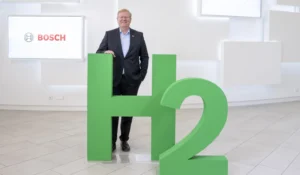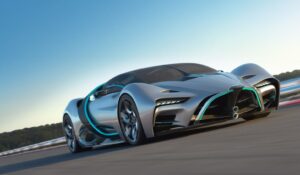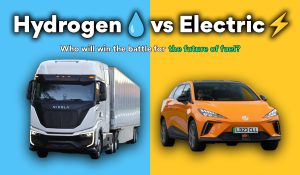What is a hydrogen fuel-cell car and how does it work?

Have you ever wondered what the future of motoring might look like? Could there be a cleaner, greener and more practical alternative to battery electric vehicles (BEVs)?
Hydrogen fuel-cell cars are here to challenge the full-fat lithium battery. They’re an emission-free, quiet, practical alternative, powered by the most abundant element in the universe – hydrogen.
Driving Hydrogen dives into the details.
What is a hydrogen fuel cell car?
At their core, hydrogen fuel cell cars are electric vehicles, but instead of plugging them into a socket to recharge, you fill them up with hydrogen. This hydrogen then reacts with oxygen in a fuel cell to generate electricity, which powers the car’s electric motor.
The perk of a hydrogen fuel cell car is that you’re driving a car that emits nothing but water vapour. No exhaust fumes, no pollutants – just a bit of water.
In the real world, the molecule is simply a more practical form of energy storage than the electron.
But how does this all work? And is it safe to drive around with tanks of hydrogen in your car?
The science: How does a hydrogen fuel cell work?
A hydrogen fuel cell is a device that converts chemical energy into electrical energy.
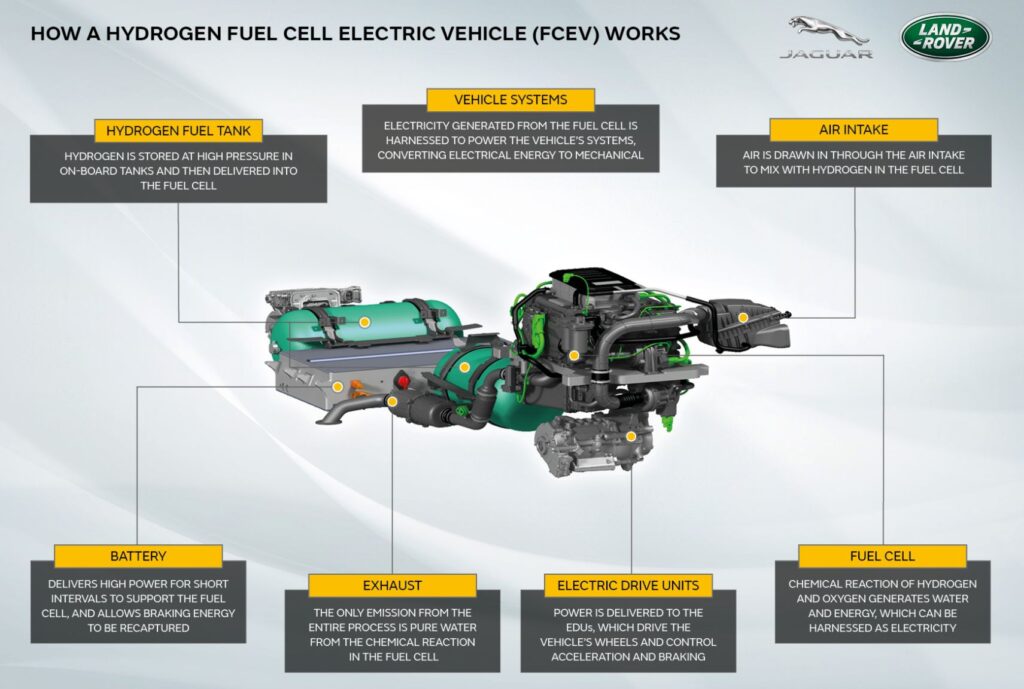
The process is:
1. Hydrogen in:
You fill up your car with hydrogen gas at the pump, which is stored in high-pressure tanks. These tanks are built to withstand the rigours of the road, and they’ve passed all the highly-stringent safety tests. The same tests, and more, that all EU pressurised containers have to go through.
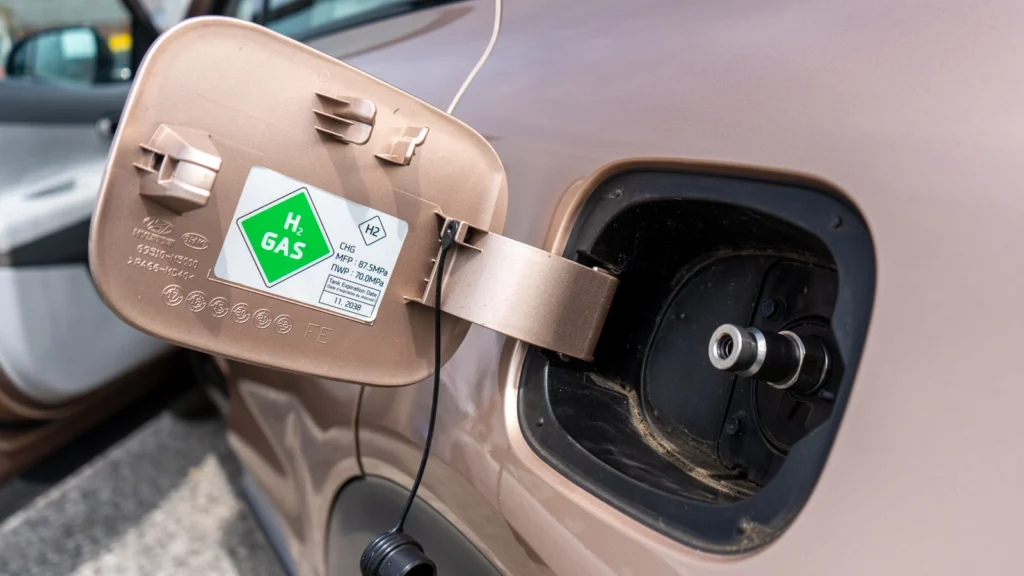
2. The wizardry happens:
The hydrogen gas then flows into the fuel cell, where it meets a catalyst – typically made of platinum. This catalyst splits the hydrogen molecules into protons and electrons. The electrons take a different route, travelling through an external circuit to generate electricity. This electricity is what powers the car’s motor.
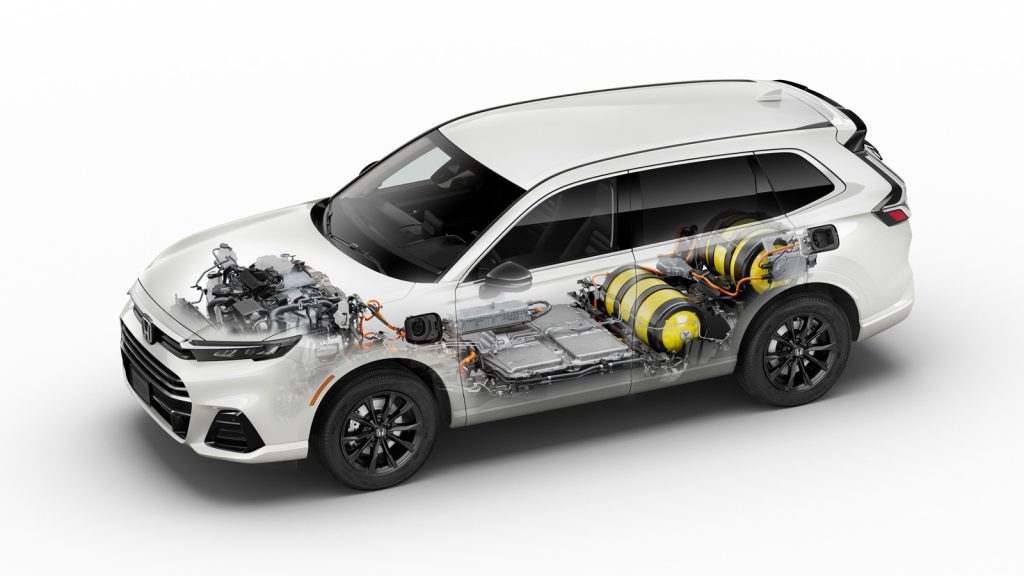
3. Oxygen (from the air) in:
Meanwhile, the protons move through an electrolyte (which you can think of like a sieve that lets the right chemicals through) to the cathode, where they meet up with oxygen from the air. Together, they form water and a bit of heat as a byproduct – both of which escape out of the exhaust pipe.
4. Propulsion occurs:
Those captured electrons (electricity) now power ultra-efficient electric motors at the wheels.
It’s a sophisticated process, but from the driver’s seat, it’s all incredibly seamless. You get the smooth, quiet drive of an electric car, but with the added convenience of quick refuelling.
Should I buy a hydrogen car?
What’s the big deal then? Why should you, a savvy and environmentally-conscious driver, consider a hydrogen fuel cell car over a battery electric vehicle (EV) or a petrol car?
Well, there are some benefits to a hydrogen car:
1. Quick refuelling:
One of the biggest advantages of hydrogen fuel cell cars is how fast you can refuel. Unlike battery-electric vehicles, which can, in some cases, take several hours to recharge, hydrogen cars can be refuelled in under five minutes.
That’s about the same time it takes to fill up a petrol or diesel car – and it’ll get you a range of 300 to 500 miles. Perfect for, literally everybody, who doesn’t like to waste their precious days sat outside of a Little Chef tethered to the mains.
2. Longer range:
Range anxiety is a real concern for many EV drivers, but hydrogen fuel cell cars have you covered. With the ability to travel up to 500 miles on a single tank, these cars are ideal for long road trips or for anyone who prefers fewer stops along the way. They also handle the cold quite well, and turning on the heater and playing your favourite Spotify playlist won’t really eat away at your range.
There is just the small infrastructure hiccup to address, which is soon going to be less of an issue as many firms are racing to build the network of filling stations across the world.
3. Zero emissions:
Here’s the big one – hydrogen fuel cell cars produce zero harmful emissions. The only thing coming out of the exhaust pipe is water vapour, making these cars some of the most environmentally-friendly vehicles on the road. In our world where reducing carbon footprints is a major talk-point, this is a major selling point.
4. Quiet operation:
Like EVs, hydrogen fuel cell cars are incredibly quiet. There’s no engine noise, just the gentle hum of the electric motor. It’s a peaceful driving experience that’s perfect for urban environments and residential areas.
5. It cleans the air as it goes:
Because fuel cells need very clean air to get their oxygen for the reaction, hydrogen fuel cell cars are usually fitted with heavy duty air filters. This means that as you drive along, the car filters out pollutants from the air, making the environment cleaner with every mile you travel.
When will hydrogen cars become mainstream?
Of course, every rose has its thorns, and hydrogen fuel cell cars are no exception. While they offer plenty of advantages, there are a few challenges that need to be addressed before they can become mainstream.
1. Cost:
Hydrogen fuel cell cars are still a bit expensive. The technology relies on some quality and costly materials like platinum, which drives up the price of the vehicles. However, as with every new technology, prices will come down as production scales up and as engineers find ways to reduce costs. It was exactly the same problem with EVs back in their infancy.
Though we are seeing price drops are companies like Bosch are investing billions in scaling up fuel cell unit production.
2. Infrastructure:
Another significant challenge – and the most pertinent one – is the lack of refuelling infrastructure. In the UK, there are currently only about 11 hydrogen refuelling stations open to the public. While there are plenty of plans in the works to expand this network, it’s still a couple of years off from the convenience of petrol stations. However, with governments and companies recognising the potential of hydrogen, we will have to watch this space.
Find your nearest hydrogen filling station with our maps:
Hydrogen Filling Stations Map UK & Europe
Hydrogen Filling Stations Map US & Canada
3. Hydrogen production:
Producing hydrogen in an environmentally-friendly way is a consideration. Currently, most hydrogen is produced by legacy means from natural gas, which isn’t exactly green.
But as there’s a massive push towards “green hydrogen” using renewable energy sources like wind and solar power, it’s an area of active development, and we can expect significant improvements in the near future as producers are scaling up.
Are hydrogen cars the future?
Despite these challenges, the future looks bright for hydrogen fuel cell cars. As more companies invest in research and development, and as governments around the world recognise the potential of hydrogen as part of a sustainable energy strategy, we’re likely to see some exciting advancements in the coming years.
Innovation on the horizon:
Automakers are already hard at work developing the next generation of hydrogen fuel cell cars. These vehicles are expected to be more affordable, more efficient, and easier to refuel. And as hydrogen production becomes greener, the environmental benefits will only increase.
Government support:
Governments across the globe are starting to see hydrogen as a key component in the transition to a low-carbon economy. In the UK, for instance, there are plans to expand the hydrogen refuelling infrastructure significantly by 2030. This will make hydrogen cars a more viable option for everyday drivers.
The EU have mandated hydrogen filling stations be installed every 200km on every major route throughout Europe, and in every ‘urban node’ – basically every big town. The deadline is for rollout is 2030.
Hydrogen beyond cars:
But it’s not just about cars – hydrogen has the potential to revolutionise the entire transportation sector. From buses and trucks to trains, boats and even planes, hydrogen fuel cells could be used to power a wide range of vehicles, reducing emissions across the board.
It’s a versatile technology that could play a major role in achieving global climate goals.
Are hydrogen cars the future
If you’re someone who values cutting-edge technology and wants to reduce your environmental impact, a hydrogen fuel cell car could be an excellent choice. While they’re not yet as widespread as battery-electric vehicles, the benefits they offer – quick refuelling, long range, zero emissions – are hard to ignore.
And if you’re concerned about the challenges, it’s worth remembering that we’re still in the early days of hydrogen technology. As infrastructure improves and prices come down, hydrogen cars will become a more practical option for a wider range of drivers.
The hydrogen revolution is just beginning
Hydrogen fuel cell cars might not be mainstream yet, but they’re paving the way for a cleaner, more sustainable future. With their impressive technology and environmental benefits, they offer a compelling alternative to both traditional and battery-electric vehicles.
So, whether you’re ready to make the switch now or just curious about what the future holds, keep an eye on hydrogen. It’s not just a fuel for the future – it’s a revolution in the making.
And who knows? In a couple of years, you might just find yourself behind the wheel of one.

